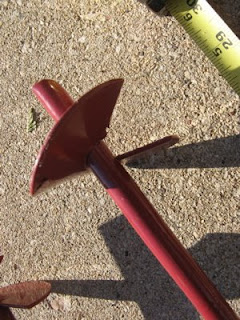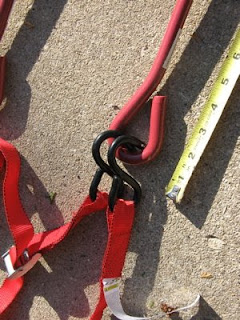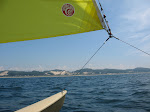The length was 16' 6 1/2" including the pintels, but because I wanted to wrap the boat to completely cover the stern, I decided to go with a 20' tarp.
Tarp sizes are quoted in total material used to make the tarp, not the actual finished tarp size. I don't know why they size according to the material size and the finished size ends up shorter, but they do, so be careful in your ordering.
The width of the tarp when I measured from the where the hull began to curve below the boat to the same spot on the other side was about 11'4", so I decided to by a 12' width tarp. The finished size width for this tarp would be around 11'6".
Note: in hindsight, I would have probably preferred to get a 14' tarp to provide more wrap under the boat.The grommets holes shown in yellow are where I would place grommets using a grommet tool that runs less than $8 at Home Depot:
The dotted lines indicate where I would initially cut the tarp. In the front, I would cut equal distance from each side of the tarp up to where the front cross-beam minus about 8 inches, so I could wrap the tarp under the cross-beam and bungee to the tarp wrapped under the rear cross-bar. Also, to provide more of a finished edge to the cut areas of the tarp, the idea was to overlap the material place some poly rope along the endge and secure it in place using the grommets through the folded material. The rope would also be tied to the end grommet.
Final width of the tarp which wrapped around the front and rear hulls would be determined once I made the initial cuts and then measured it with the tarp on the boat. I'd also determine the final design for wrapping the tarp around the bows and stern, once the initial cuts were made. My original throughts were to make custom cuts and do the same doubling up of the material to provide a finished edge and securing the edges with grommets.
I searched the web and found several places that sold a 12' by 20' heavy duty tarp. They have different colors, but I chose the silver as I thought it would reflect heat better. Also, most sites offered poly tarps that had UV protection. I have seen the sun eat up a regular poly tarp like you get at the hardware store in a year or two, so I wanted this to last a little more given I was doing some extra work on it.
I ended up buying from A1tarps.com: http://www.a1tarps.com/product.jhtm?id=177&cid=21

They had the lowest price on the size tarp I wanted $30.24. Here is the description off the web site:
Silver heavy-duty tarps- 14X14 Mesh Count, 12 Mil Thickness, 6 oz per square yard, aluminum grommets every 18 inches with rope reinforced corners and eyelets. All of our silver heavy-duty tarps are weather-proof- providing 100% UV Protection and Shade. Every tarp is Waterproof, Mildewproof and Rotproof.
When the tarp arrived, I was impressed by the weight of the material. The sun will eventually shread it, but I felt it would last longer than any tarp I purchased thus far.
I laid it out on the boat and the size was just about right, and given the custom work I'd have to do for the front and rear hulls, I was glad I had a little more material to work with. Given that I have to cut the front, the excess material may come off of that end of the boat.













































